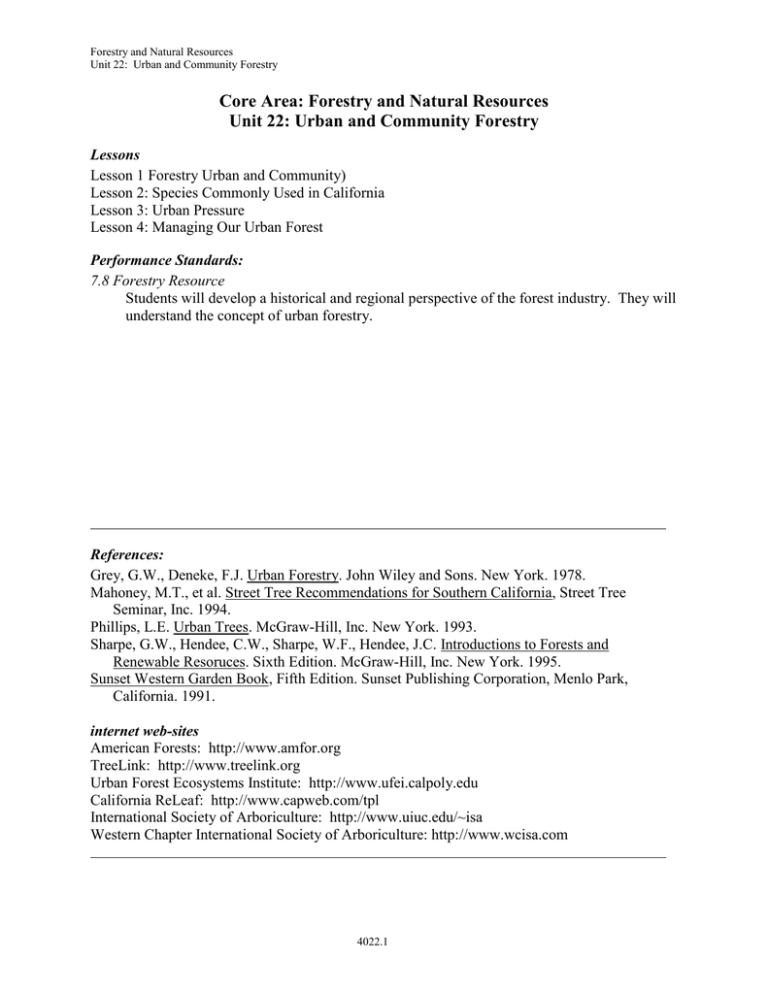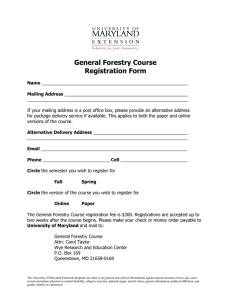Lesson 1 Forestry Urban and Community
advertisement

Forestry and Natural Resources Unit 22: Urban and Community Forestry Core Area: Forestry and Natural Resources Unit 22: Urban and Community Forestry Lessons Lesson 1 Forestry Urban and Community) Lesson 2: Species Commonly Used in California Lesson 3: Urban Pressure Lesson 4: Managing Our Urban Forest Performance Standards: 7.8 Forestry Resource Students will develop a historical and regional perspective of the forest industry. They will understand the concept of urban forestry. References: Grey, G.W., Deneke, F.J. Urban Forestry. John Wiley and Sons. New York. 1978. Mahoney, M.T., et al. Street Tree Recommendations for Southern California, Street Tree Seminar, Inc. 1994. Phillips, L.E. Urban Trees. McGraw-Hill, Inc. New York. 1993. Sharpe, G.W., Hendee, C.W., Sharpe, W.F., Hendee, J.C. Introductions to Forests and Renewable Resoruces. Sixth Edition. McGraw-Hill, Inc. New York. 1995. Sunset Western Garden Book, Fifth Edition. Sunset Publishing Corporation, Menlo Park, California. 1991. internet web-sites American Forests: http://www.amfor.org TreeLink: http://www.treelink.org Urban Forest Ecosystems Institute: http://www.ufei.calpoly.edu California ReLeaf: http://www.capweb.com/tpl International Society of Arboriculture: http://www.uiuc.edu/~isa Western Chapter International Society of Arboriculture: http://www.wcisa.com 4022.1 Forestry and Natural Resources Unit 22: Urban and Community Forestry Unit 22: Urban and Community Forestry Lesson 1: Forestry Urban and Community Duration: 2 Hours Students will be able to: 1. Define urban and community forestry. 2. Discuss urban forestry from a historical perspective. 3. List the major benefits of urban trees. Suggested Activities: 22.1A Urban and Community Forestry ; Define urban and community forestry. 22.1B Discussion - Discuss the values and importance of urban trees in your community. Teaching Outline I. Introduction A. Urban and Community Forestry: the cultivation and management of trees within a populated area and/or rural areas that are significantly impacted by rural environments; focuses on the importance and benefits of trees, including psychological, social, economic and environmental II. Historical Perspective A. Early uses of urban trees included food and shade 1. Late 1500s: the term “arborists” was invented in England 2. From the 1700s on the field of landscape design grew a. Advent of botanical gardens and arboretums b. Diverse variety of plants available because travelers imported plants from home to the “new world” c. Focus shifts from food and shade to relaxation and enjoyment 3. Tree-lined neighborhoods and open space characterized many early western cities, including London, Paris and New York City 4. “urban forestry” originated in Europe a. American botanists traveled to Europe to study b. City planners in Philadelphia, Boston, New York City and Savannah stresses the importance of public green space, as well as neighborhood plantings and tree preservation 1.) In the early 1800s, Mt. Auburn Cemetery in Cambridge, MA became the first planned landscaping of a public area; included over 450 native and exotic tree species 2.) Mid-1800s Frederick Olmstead designed New York’s Central Park 3.) 1872 J. Morton sterling declared the first Arbor Day, which was celebrated by the planting of over one million new trees in Nebraska 4022.2 Forestry and Natural Resources Unit 22: Urban and Community Forestry sIII. Value and Benefits of Urban Trees A. Shade and cooling: energy conservation 1. Reduce money spent on heating and cooling a. Three well-placed trees around a house can lower cooling costs by 10 - 50% 2. Deciduous trees provide shade in the summer and filter through sun in the winter 3. Serve as a wind-break (moderates temperature) 4. Reduces atmospheric carbon dioxide, a major contributor to the greenhouse effect and global warming 5. Reduces the need for other fossil fuels, further slowing carbon dioxide out-put a. Urban areas are 5 - 10 degrees (f) warmer than surrounding rural areas b. “urban heat islands” result in one million dollars/hour in cooling costs, producing millions of tons of carbon dioxide 6. Trees reduce carbon dioxide induced smog and haze B. Human environmental benefits 1. Produces oxygen and absorbs carbon dioxide 2. Provides windbreaks 3. Slows erosion and urban run-off 4. Recreational uses a. City parks and open space b. Provides informal nature recreation and observation (e.g., Walking, nature hikes, bird watching) 5. Food/fruit 6. Reduces glare 7. Conserves water 8. Reduces noise pollution 9. Psychological effects a. Calming; creates a feeling of relaxation b. Trees help to define space C. Urban wildlife habitat 1. Trees provide food and shelter for a wide variety of urban animals 2. Careful selection can attract certain species of animals/birds, helping to re-establish native wildlife that has declined due to urbanization D. Aesthetics 1. Trees increase property values 2. “soften” harsh architectural features 3. Help to define space 4022.3


